Caesarea Philippi (Banias)
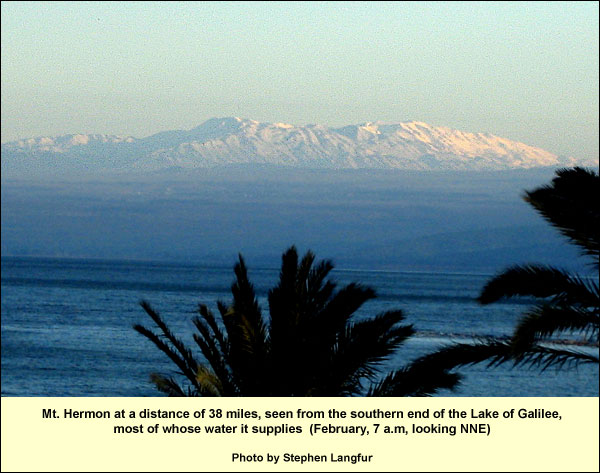
At Banias this "something" was erosion. The spring bubbles out of a cliff in the western face of Mt. Hermon, giving 160 million cubic metersOne cubic meter = 1000 liters. One liter = 1.056 liquid quarts of water per year. Despite the spring, and despite the good soil in the area, no major town developed here in the First Testament period. The proximity of Dan was probably a reason. The Danites, who sat on an even bigger spring, would not have brooked competition so near. For here was the junction of three major roads: (1) the northern branch of the Great Trunk Road between Egypt and Damascus; (2) the road connecting the latter with the sea at Tyre, the so-called via maris (3), the road to the Tigris. History did not set a firm foot in Banias, therefore, until the Greeks arrived. After the death of Alexander the Great (323 BC), his successors Ptolemy and Seleucus became rivals for the huge area he had conquered. At first the Egypt-based Ptolemies ruled the land, but around 200 BC, the Seleucid Antiochus III, ruling from Syria, defeated them and took over the country.
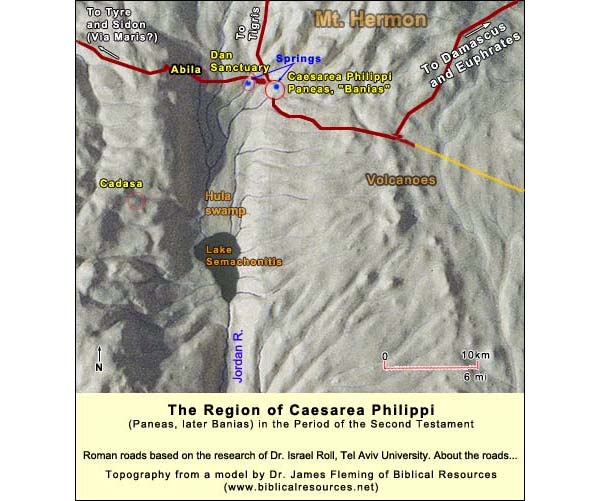
The historian Polybius (2nd century BC) tells us that the battle occurred at a place he knew as Paneon (meaning, the sanctuary of Pan). The name Banias reflects the Arabic pronunciation for Paneas, "city of Pan," sometimes called Paneon. Since no other location in the land bears such a name, the site of the crucial battle was probably here. Polybius also reports that Antiochus used elephants, which threw the enemy into a panic. Now the Greeks had a god, one of whose attributes was to cause panic in battle (Gr. panika), and his name was (not by coincidence) Pan. It may be, then, that the famous panic of the decisive battle led the Seleucids to erect a sanctuary here to Pan.
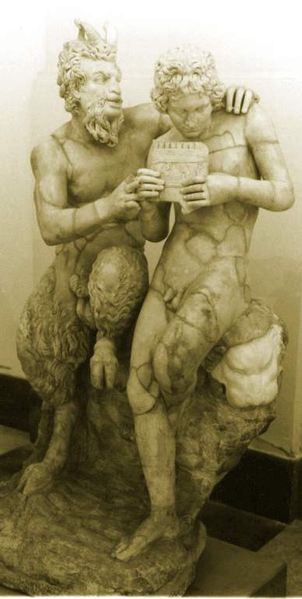
But what was it about Pan, such that the Greeks took his name for panic? He was famous for his great cry, which echoed. Perhaps it was originally a battle cry, such as causes panic. As for the echo, Pan fell in love with a virgin named Echo, who resisted his advances, for he was ugly, hairy and goat-legged. Finally, he had his minions catch her and rip her to pieces. They buried her remains in many places, and that is why, when one gives a great shout, the echo comes from many places. Echo too was revered here. Above the spring there are niches carved in the face of the cliff, with inscriptions. They contained statues, which have disappeared. From the inscriptions, however, we know that one was dedicated to Pan, one to the emperor and one to Echo. Pan was also a god of the hunters, and his echoing shout could easily disorient them in the forests of Greek Arcadia, where he first appeared.
But above all, he was god of the goats: hence, his peculiar legs. Playing his pipe, he would entice the goats into a dance, which ensured the fertility of the herds. On the left, in a Roman copy of a Greek statue (in the public domain), he teaches the shepherd Daphnis to play. Pan was a fertility god, famous for lust. The abundance of the vegetation at Banias, together with the rush of the spring, perhaps suggested to the Greeks the rush of human passion, and thus the presence of Pan. In addition to the history, the lushness of the site itself evokes him. In the year 20 BC, the Emperor AugustusOriginally Octavian, the adopted son of Julius Caesar. He became one of the triumvirate, along with Marc Antony and Lepidus, that ruled Rome after Caesar's assassination in 44 BC. At the Battle of Actium in 31, he defeated Antony and became the sole ruler of the Roman Empire, remaining in power until his death in 14 AD. The Senate awarded him the name Augustus ("revered"), Sebastos in Greek. The stability during his reign introduced a Roman peace (pax romana) upon the Mediterranean world (a factor that later helped make possible the rapid spread of Christian faith) gave the sanctuary and the untamed regions around it to HerodHerod ruled the land under Roman auspices from 37 - 4 BC. After his death, the Romans called him "the Great" because of his building activities. Christians chiefly remember him, however, as the killer of the innocent children (Mt. 2: 16), who honored his benefactor with a temple above the spring. Its remains are still visible before the large cave. Herod willed the area to his son Philip, who was the first to found a city here: Caesarea Philippi, the capital of his tetrarchy. The worship of Pan continued to thrive. Into the region of Caesarea Philippi came Jesus and his disciples, and here they conducted a crucial conversation, known as the confession of Peter.
{mospagebreak title=Pan sanctuary} The Pan sanctuary
Above the spring in the Roman period, dominating the city on its northern end, was a group of shrines. Only their foundations have survived. On the west side, there is a cave, which served as the sacred grotto of the temple that Herod the Great built here in 19 BC to honor his patron, Augustus. To its left are niches for statues. We have an idea what the temple looked like, because the city minted coins with its image, showing four Ionic columns in front. From JosephusJosephus Flavius (36 – 100 AD), Jewish general, one of two directing the revolt against Rome in Galilee. After Vespasian captured him, he prophesied the latter would be emperor. When this proved true, the Romans honored him. He then turned historian, writing The Jewish War, The Antiquities of the Jews and many other books. Because of a paragraph about John the Baptist (and maybe a sentence about Jesus), the Church preserved his works we also have a description of the grotto, which had water, and the gushing spring beneath: And when Caesar had further bestowed upon him another additional country, he built there also a temple of white marble, hard by the fountains of Jordan: the place is called Panium, where is a top of a mountain that is raised to an immense height, and at its side, beneath, or at its bottom, a dark cave opens itself; within which there is a horrible precipice, that descends abruptly to a vast depth; it contains a mighty quantity of water, which is immovable; and when any body lets down any thing to measure the depth of the earth beneath the water, no length of cord is sufficient to reach it. Now the fountains of Jordan rise at the roots of this cavity outwardly; and, as some think, this is the utmost origin of Jordan: but we shall speak of that matter more accurately in our following history. (Josephus, WarJosephus Flavius. The Wars of the Jews, translated by William Whiston. , Book I. 21.3)
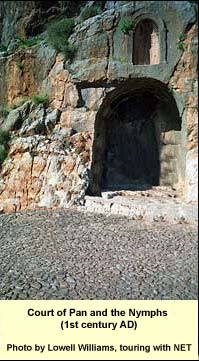
Ascending a bit to the right, one enters the Court of Pan and the Nymphs, dated to the 1st century AD. It was open to the sky. The grotto that is carved in the cliff belonged to it. In 148 AD the niches were added and statues put in, as indicated by this inscription: "The priest Victor, son of Lysimachos, dedicated this goddess to the god Pan, lover of Echo."
The next shrine to the right was a temple to Zeus, and beside that a courtyard dedicated to Nemesis, goddess of revenge, whose cult was (and is, though not by name) a regional favorite. The inscription above it mentions her shrine, which "was made by cutting away the rock underneath."
Stepping further to the right (east), we see a wide hall with two low galleries on either side, supported by rectangular niches. These contained pottery shards "and a large quantity of animal bones, mainly of sheep and goats, bringing to mind the cult of the sacred goats related to the god Pan, as depicted on Roman coins of the city of Panias. These finds suggest that the structure was used as a temple-tomb for the interment of the bones of the sacred goats, whose cult was probably practiced in the buildings excavated at Banyas." (Source: Israel Ministry of Foreign Affairs. Details.)
Below on our right, we see an apse, which was partitioned off from the rest of the building. It is thought that the sacred goats used to dance here to the music of the Pan flutes, played by the priests beyond the partition.
{mospagebreak title=Peter's confession} The confession of Peter (followed by a comment)
Matthew 16:13-28 Now when Jesus came into the parts of Caesarea Philippi, he asked his disciples, saying, “Who do men say that I, the Son of Man, am?” They said, “Some say John the Baptizer, some, Elijah, and others, Jeremiah, or one of the prophets.” He said to them, “But who do you say that I am?” Simon Peter answered, “You are the Christ, the Son of the living God.” Jesus answered him, “Blessed are you, Simon Bar Jonah, for flesh and blood has not revealed this to you, but my Father who is in heaven. I also tell you that you are Peter, and on this rock I will build my assembly, and the gates of Hades will not prevail against it. I will give to you the keys of the Kingdom of Heaven, and whatever you bind on earth will have been bound in heaven; and whatever you release on earth will have been released in heaven.” Then he commanded the disciples that they should tell no one that he was Jesus the Christ. From that time, Jesus began to show his disciples that he must go to Jerusalem and suffer many things from the elders, chief priests, and scribes, and be killed, and the third day be raised up. Peter took him aside, and began to rebuke him, saying, “Far be it from you, Lord! This will never be done to you.” But he turned, and said to Peter, “Get behind me, Satan! You are a stumbling block to me, for you are not setting your mind on the things of God, but on the things of men.” Then Jesus said to his disciples, “If anyone desires to come after me, let him deny himself, and take up his cross, and follow me. For whoever desires to save his life will lose it, and whoever will lose his life for my sake will find it. For what will it profit a man, if he gains the whole world, and forfeits his life? Or what will a man give in exchange for his life? For the Son of Man will come in the glory of his Father with his angels, and then he will render to everyone according to his deeds. Most certainly I tell you, there are some standing here who will in no way taste of death, until they see the Son of Man coming in his Kingdom.” Is there a reason why this conversation occurs precisely here, in the region of Caesarea Philippi? Three points may be relevant: In the synoptic gospelsMatthew, Mark and Luke have many parallel passages and appear, therefore, to be closely related. They are called the synoptic Gospels from the Greek sun- ,"together," plus opsis, "view.", to which this report belongs, Jesus does not readily proclaim himself as the Messiah. Until this point in Matthew, he has not done so.
After Peter acknowledges him as the Messiah and Jesus blesses him, Jesus tells the disciples not to spread this word. He goes on to describe what will happen to him in Jerusalem.
The population of the area was heavily pagan. There were few Jews here.
The choice of Caesarea Philippi for this conversation would appear to be connected, then, to Jesus' reticence. For some reason, he does not yet want this news to spread among his fellow Jews.
On another note: Peter's position is typical for him. Having been raised up by the blessing, almost at once he is cast down by condemnation. This kind of thing recurs often with Peter. Compare his walk on the water, followed by doubt, in Matthew 14, and later his attempt to stay near the arrested Jesus, followed by his denial (Matthew 26: 69-74).
{mospagebreak title=Palace } The Palace Upon entering Banias, ask if the palace is open.
To gain access to it, we need to start on the nature trail, passing under a small but complete Roman bridge whose arch is covered with travertine (the stone that forms on the bottom of teakettles). We pass a Syrian hydroelectric station (defunct) and a 19th century flour mill, sometimes active. Continuing on the trail, we come to a fork and go left (with the sign, "To Agrippas' palace"). Going straight would take us, after about 45 minutes, to a powerful waterfall, from which there is an ascent to a different parking lot from the one we arrived in. But we go left.
We know from Josephus that the Jewish king Agrippas II (who heard Paul speak at Caesarea Maritima) had his capital here at the other Caesarea during his extremely long reign (from 53 AD until 93 AD or longer). The palace must have belonged to him. This Agrippas attempted in vain to dissuade his fellow Jews from rebelling against Rome. After the revolt was over, he hosted the troops of Titus at Banias, and many Jewish captives found their deaths in the entertainments. Here Titus began his torrid love affair with Berenike, Agrippas' sister, and would have made her Empress had the Romans not refused to accept a Jewess. He may even have contributed this palace as a kind of consolation prize. (Berenike found her way, in a sense, to the Via Dolorosa in Jerusalem. See the Sixth Station there.)
The first floor of the palace is remarkably well preserved. It may seem like a basement today, because one walks down to get into it, but it stood above ground 2000 years ago. The plan is symmetrical. Walking through a hallway with remarkable masonry, cut in curves to almost mathematical perfection, one goes under the modern street. The entrances were narrow and flanked by great round towers, of which the bases remain.
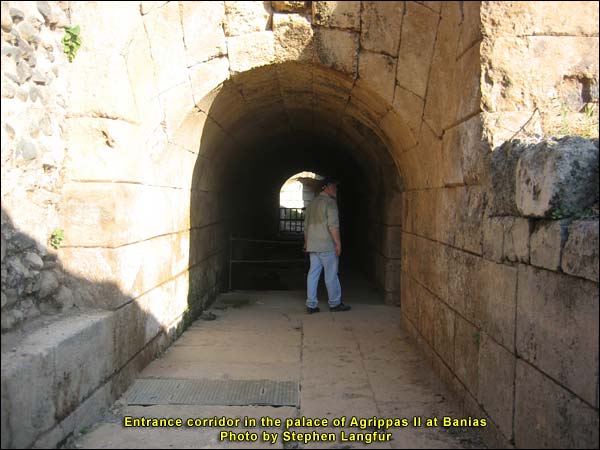
For more on the palace,seeWilson and TzaferisWilson, John F. and Vassilios Tzaferis, "Banias Dig Reveals King's Palace." Biblical Archaeology Review, January/February 1998. {mospagebreak title=Logistics} Logistics and Opening Hours Phone: (04) 690 2577 or 695 0272 Nature Reserves and National Parks (Main office: 02/500-5444)
Opening hours:
April 1 through September 30, from 8.00 - 17.00. (Entrance until 16.00)*
October 1 through March 31, from 8.00 - 16.00. (Entrance until 15.00)* *On Fridays and the eves of Jewish holidays, the sites close one hour earlier. For example, on a Friday in March one must enter by 14.00 and leave by 15.00.